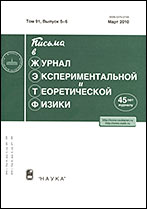|
This article is cited in 2 scientific papers (total in 2 papers)
METHODS OF THEORETICAL PHYSICS
On the two-dimensional classical motion of a charged particle in an electromagnetic field with an additional quadratic integral of motion
V. G. Marikhin
Landau Institute for Theoretical Physics, Russian Academy of Sciences
Abstract:
The problem of quadratic Hamiltonians with an electromagnetic field commuting in the sense of the standard Poisson brackets has been considered. It has been shown that, as in the quantum case, any such pair can be reduced to the canonical form, which makes it possible to construct the complete classification of the solutions in the class of meromorphic solutions for the main function of one variable. The transformation to the canonical form is performed through the change of variables to the Kovalevskaya-type variables, which is similar to that in the theory of integrable tops. This transformation has been considered for the two-dimensional Hamiltonian of a charged particle with an additional quadratic integral of motion.
Received: 11.03.2013
Citation:
V. G. Marikhin, “On the two-dimensional classical motion of a charged particle in an electromagnetic field with an additional quadratic integral of motion”, Pis'ma v Zh. Èksper. Teoret. Fiz., 97:7 (2013), 491–495; JETP Letters, 97:7 (2013), 425–428
Linking options:
https://www.mathnet.ru/eng/jetpl3397 https://www.mathnet.ru/eng/jetpl/v97/i7/p491
|


| Statistics & downloads: |
| Abstract page: | 275 | | Full-text PDF : | 95 | | References: | 69 | | First page: | 13 |
|





 Contact us:
Contact us: Terms of Use
Terms of Use
 Registration to the website
Registration to the website Logotypes
Logotypes









 Citation in format
Citation in format 
